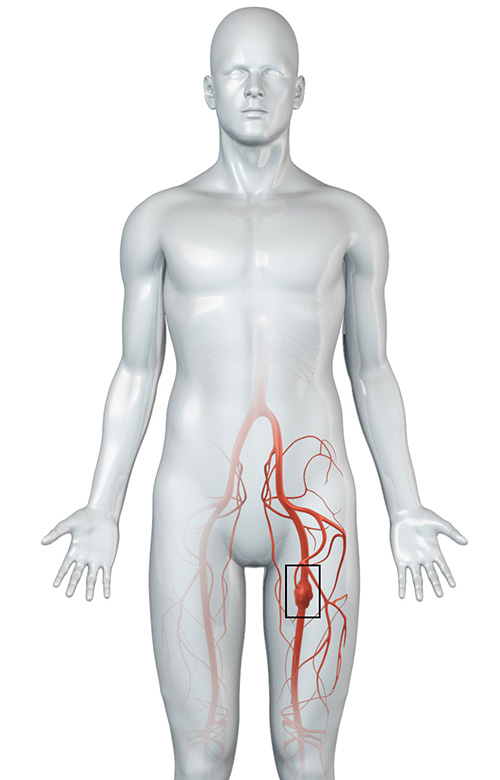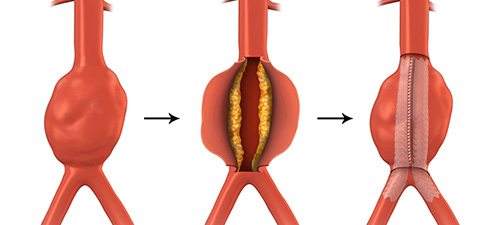Peripheral Artery Aneurysm
What is a Peripheral Arterial Aneurysm?
An aneurysm is a condition where the walls of a blood vessel weaken. Over a period of time, the pressure of the blood flowing through the vessel causes it to expand or bulge at the point of weakness.

A peripheral arterial aneurysm (or ‘PAA’) is called thus because it occurs in the arteries other than the aorta, your body’s largest artery.
Peripheral arterial aneurysms most commonly develop in the popliteal artery, which runs down the lower part of your thigh and knee. Less common areas for a peripheral arterial aneurysm to occur in are:
- Femoral artery (located in the groin)
- Carotid artery (located in the neck)
- Arteries in the arms
- Arteries supplying blood to the kidneys or bowel (a visceral aneurysm)
Other common vessels that an aneurysm can occur in are:
What causes a Peripheral Arterial Aneurysm?
The cause of aneurysm is not known, but there are numerous risk factors that include:
- Family history - genetics plays a significant role
- A history of smoking
- High blood pressure
- High cholesterol
- Atherosclerosis (hardened arteries)
If you are known to have, or if you are likely to develop aneurysm disease it is recommended that you optimise your lifestyle by:
- Controlling high blood pressure
- Controlling cholesterol
- Ceasing smoking
- Exercising regularly
If a peripheral arterial aneurysm is found in one leg, you are at greater risk of having one in the other leg. Peripheral arterial aneurysm also increases your risk of developing an aortic aneurysm.
What are the signs/symptoms of a Peripheral Arterial Aneurysm?
Most people do not feel any symptoms with a peripheral arterial aneurysm, especially if it is small. The warning signs that you may have an aneurysm that is at risk of rupture, or is growing rapidly, depend on where it is and its size.
Sometimes there are no symptoms, however, if the aneurysm does become symptomatic, the signs can include:
- A throbbing lump that you can feel in the area of the aneurysm
- Cramping in the legs when exercising
- Pain at the location of the aneurysm (usually arm or leg)
- Sores on your fingers or toes that do not heal
- Radiating numbness
- Gangrene (tissue death)
- Abdominal pain (in the case of femoral or splenic aneurysm)
- Fainting (which may indicate internal bleeding)
- Weakness in the arm, leg, neck, fingers or toes.
- A painful, discoloured toe, also known as “blue toe”
How will a Peripheral Arterial Aneurysm affect my health?
The effects of a PAA on your health is dependant on how quickly it grows, where it develops and how likely it is to rupture.
The worst effects of a Peripheral Arterial Aneurysm are life-threatening or life-altering complications from a rupture, such as internal bleeding and clots that travel to the heart or brain, causing heart attack, embolism or stroke.
Peripheral Arterial Aneurysms smaller than 2cm may only need lifestyle changes, a watchful eye and regular checkups with the doctor.
A Peripheral Arterial Aneurysm will never go away unless treated.
What are the stages of an Aneurysm?
PAA’s begin at different sizes, grow at different rates and can be symptomatic, or asymptomatic, so it is difficult to neatly put an PAA into clear stages.
In saying this, all PAA’s begin with a weakening of the arterial wall. The weakened point may then grow into a larger, unstable area. At this point the aneurysm will bulge under the internal pressure of the blood flowing through the artery.
Onwards, the aneurysm can either withstand the pressure difference relatively easily, or it may worsen, and possibly result in a rupture. This process can be very quick (instant), or very slow (over years).
Considering these factors, a regular ultrasound for PAA is recommended, especially if you fall into one of the higher risk groups mentioned above, in ‘What causes a Peripheral Arterial Aneurysm?’
PAA’s are usually treated once they are larger than 2cm in diameter, but are sometimes treated when they are smaller than this. Treatment is required earlier for a PAA than an AAA or TAA, because all arteries are smaller than the aorta.
Asymptomatic aneurysms under 2cm in size are usually monitored with regular ultrasound and/or CT angiograms with reviews from a vascular surgeon.
I think I have an Aneurysm – What should I do?
If you think you are at risk of having an aneurysm OR have a family history of aneurysm you should:
- See your GP: If you are in a high risk group, experiencing some pain or if you are visiting your GP for routine reasons, get a check for PAA with your GP. They may find evidence of a PAA as some can be felt during an examination. In some instances, patients have been sent for tests for something else and those tests identify the PAA, so if you are concerned, please investigate your health with a GP first. If evidence presents of a Peripheral Arterial Aneurysm, your GP will almost always send you onto a Vascular Surgeon.
- See a Vascular Surgeon: Our surgeons at Sydney Vascular Surgery will likely send you for tests to determine the size and shape (morphology) of your aneurysm.
Your surgeon will take a detailed history and perform a physical examination, which will include listening to your heart, examining the area and assessing the pulses in your neck, arms and legs both by hand and with a stethoscope. Your surgeon will then either recommend more tests or recommend a course of treatment.
If your aneurysm is under surveillance (ie: it is asymptomatic and smaller than the treatment cut-off size), you would normally have a non-invasive ultrasound at a specialised vascular ultrasound practice on a regular basis as advised by your Vascular Surgeon.
If your aneurysm requires treatment you will require a CT angiogram of the artery so that your surgeon can look very closely at how to best treat it. Sometimes your surgeon will want to perform a diagnostic angiogram themselves if they want to clarify anything that the CT doesn’t.
It is common for your surgeon to also request that you be:
- reviewed by a cardiologist before you undertake any surgery
- have your renal function assessed and
- have your carotid arteries scanned
to ensure there is no other hidden disease present that would put you at higher risk of periprocedural complications.
Course of Treatment will be discussed with you once your surgeon knows the results of your ultrasound/s, tests and consultations. With this information, they are in a great position to advise you on your options for treatment, which could include surgery, surveillance, and adjustment of lifestyle factors and addition of medications.
What if I don’t have my Peripheral Arterial Aneurysm treated?
Some aneurysms may never require treatment and can simply be monitored on a regular basis, but:
You must not risk leaving any aneurysm unassessed.
A rupture of an aneurysm can lead to internal hemorrhaging and can be fatal. It is critical to maintain a strict assessment and monitoring regime of any aneurysm.
What treatment options does SVS offer for an Aneurysm?
At Sydney Vascular Surgery we utilise a range of treatments from conservative measures, through to minimally invasive surgery, and major surgery.
Conservative management
For small, manageable or asymptomatic PAA’s, conservative management is an ideal first step. This involves observation, tests and actions from you and your medical professionals:
- A regular GP checkup
- Regular ultrasounds to check on the size and rupture or clotting risk of the PAA.
- Ongoing surveillance of your symptoms
- Prompt notice of any changes you feel in your body
- Taking up positive lifestyle changes such as:
- Exercising.
- Quitting smoking.
- Controlling high blood pressure and cholesterol.
- Eating well.
Not all aneurysms will require treatment and, for some patients, the risk of treatment such as surgery is too great in the presence of other health concerns.
Surgery
We must note here that having an aneurysm repaired is a large operation that carries risks and it must be considered that the patient is fit enough to endure the treatment.
Once it is considered that surgical treatment of an aneurysm is less risky than leaving it untreated, surgery will be arranged.
Surgical procedures include:
Endovascular Aneurysm Repair (EVAR)
EVAR is a minimally invasive surgery where a stent graft (a fabric covered wire frame in the shape of a tube) is inserted inside the artery via small entry incisions. The stent acts as a structural support and strengthens the arterial wall.

Planning for this type of repair is very precise and your surgeon will often seek advice on latest stent technologies from manufacturers and review all CT images in great detail.
In complex aneurysm cases, there may be multiple vascular surgeons involved in the surgery.
EVAR is a technique that our surgeons have a great deal of experience in. They will spend time with you to discuss each stage of the surgery in detail. Everyone is different and every aneurysm is different, so rest assured that your unique case details will be intricately planned for.
Open aneurysm repair
This treatment is often reserved for cases not suitable for endovascular treatment (EVAR). This is because it places the body under much greater stress than an endovascular approach. This is the ‘traditional’ treatment for aneurysms, involving an open surgery to replace the diseased blood vessel with an artificial blood vessel (graft).
In the conventional open operation, a large incision is made to reveal the aneurysm. The blood vessels above and below the aneurysm are clamped and the aneurysm itself is opened. Any blood clot in the aneurysm is removed and any bleeding blood vessels are controlled. The artificial graft is then stitched into place using permanent stitches.
Alternatively, a synthetic or natural bypass graft is attached to the artery to reroute the blood away from, or around the aneurysm.
Emergency treatment for ruptured aneurysms
A ruptured aneurysm is a dangerous occurrence. Patients who do not die from a ruptured aneurysm may present to hospital as an emergency usually with pain. In this instance, the most common procedure for emergency aneurysm rupture repair is Open Aneurysm Repair.
EVAR has been performed on some ruptured aneurysms to some success, but only through the availability of well-manned units with top class radiological/operating facilities and considerable experience of endovascular repair.
In the event of suspected aneurysm rupture, you MUST present at your nearest hospital Emergency Department immediately.
Helpful Links:
Peripheral Artery Aneurysms (PAA) http://www.anzsvs.org.au/patient-information/popliteal-aneurysms/
Risk of Anaesthetic http://www.anzca.edu.au/patients/frequently-asked-questions/risks-and-complications.html







